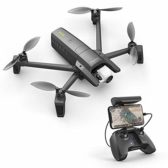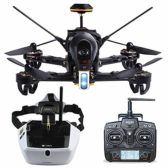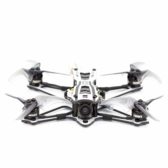The Best VR Drones in 2021: Drones with Virtual Reality!
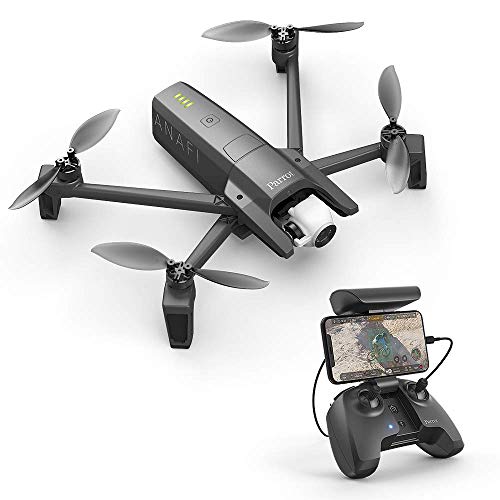
Parrot Anafi FPV
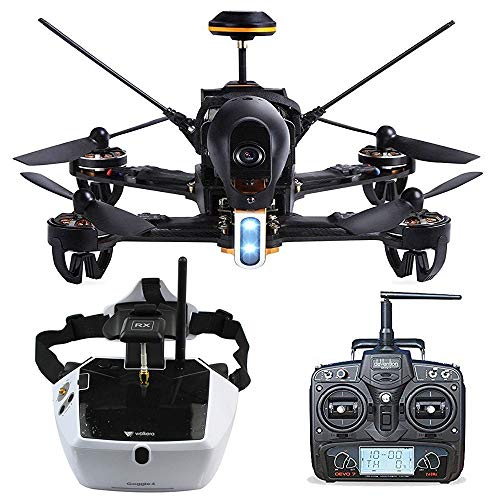
Walkera F210
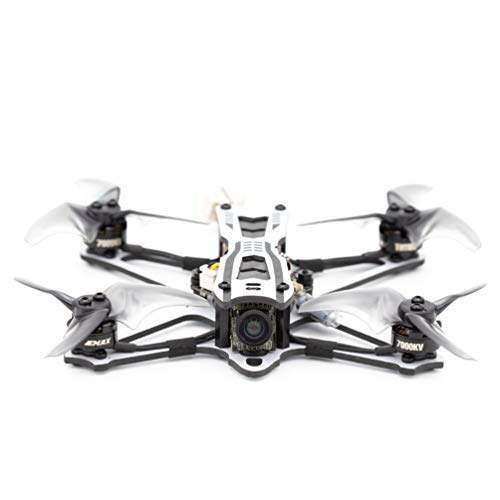
EMAX Tinyhawk
When it comes to flying in FPV, nothing beats the experience of using a VR headset. The immersiveness and precision you get is second to none and gives a new dimension to drone piloting.
However, some owners might be reluctant because of the added cost of buying a separate VR headset. Hence, not many get to try this fun way of flying a drone.
Fortunately, there are a lot of drones with VR headsets bundled in. You’ll also be surprised to discover that some of these cost less than $100, all in!
So today, we’ll take a look at the best drone and VR packages you can buy for the complete FPV experience right out of the box!
What is a VR Drone?
Simply put, a VR drone is an FPV drone with a VR headset packaged in.
An FPV (First Person View) drone utilizes its onboard camera to make you see what the drone sees. This footage is sent directly, in real-time, to an FPV monitor. This usually is your smartphone or an LED screen mounted on your controller.
In the case of a VR drone, however, that live feed is sent to an FPV goggle, which is worn by the pilot. This gives the illusion of the pilot being “inside” the drone as if he’s driving it there himself. Flying a drone in FPV mode using a VR headset is the most immersive way to fly.
FPV headsets or goggles are usually bought separately, but some are bundled in with the drone. This is often seen with racing drones. This is much more convenient and can save you a bit of money in the long run.
VR drones are widely used in racing since it allows the pilot to have a better reaction time in response to seeing obstacles on the way. It’s the only way to gain the precision needed to survive a drone racing obstacle course.
The Best VR Drones
We may receive compensation on qualifying purchases via our links. This does not change how we review items. For more information, please read our affiliate disclosure.
Immerse yourself in your photos and videos thanks to the Anafi FPV’s included Cockpitglasses.

- Flight Time: ~27 minutes
- Charge Time: ~360 minutes
- Range: 4000m / 2.48mi
- Remote Controller: WiFi 5.4GHz & 2.4Ghz (included in the set)
- Camera: 90° adjustable lens 2K Camera with 12MP
- Live Video Transmission Range: 3500m / 2.17mi
- Weight: 315g / 11.11oz
- Working Temperature: 0°C to ~ 40°C
- Rated for indoor and outdoor use
While at first glance the Anafi base model and the FPV look very similar, they have a few interesting differences that will push realtors to one side or the other. Primarily, you can use the FPV kit to enter the drone’s point of view, and thus your client’s.
This larger model is specially designed for allowing others to see exactly where you have gone and experience the same things as the pilot. When it comes to large and exclusive properties, this can be your key to the sale.
Basically, the Anafi FPV will allow you to survey the property remotely and transfer your experience to the screen directly. This will give your audience a more intimate feeling when watching the footage.
By using the FPV goggles, you can virtually enter the drone and slowly make a tour of the property in question. By calmly talking about what you see, you can give an online tour that will be as specific as the one you can give in person.
And the battery time of roughly 27 minutes (~4% more than the base model) you can give a detailed count of everything you see. This will save you loads of time and attract only the customers that are willing to close immediately.
The lens and the camera are the same as the base model. Because of the wider wing-span, this does make the FPV model more stable than the base one, which improves your first-person experience, and that of your customers.
+ Pros
- Cons
The Walkera F210 is our number one pick as the best drone with night vision.

- Flight Time: ~9 minutes
- Charge Time: ~120 minutes
- Range: 400m / 1312ft
- Remote Controller: WiFi 5.8GHz (included in the set)
- Camera: 700TVL night vision camera
- Live Video Transmission Range: 400m / 1312ft
- Weight: 375g / 13.22oz
- Working Temperature: ~-10°C to ~+40°C
- Rated for indoor and outdoor use
The Walkera F210 is one of the most beloved racing drones in Walkera’s roster, thanks in part to its agile handling and fast speeds. Packaged with Walkera’s own 5.8 GHz Goggle 4, it takes that experience to a whole level.
Goggle 4 is a box type FPV headset with a single 5 inch HD screen. Right off the bat, it was comfortable to wear when we tried it on. The padding on the contours are soft and comfortable, and the weight is manageable at 528g.
The screen itself is also made of optical components that are soft on the eyes, and won’t wear them out as fast. You’ll be able to tweak things like brightness and contrast to make it as comfortable to your eyes as possible.
It’s capable of forming a stable connection with the drone, as it has two 5.8 GHz antennas and can operate in 40 channels. Battery life is substantially long and can power up to 120 minutes of continuous viewing.
The Goggle 4 is the perfect complement to the F210 drone’s onboard 700 TVL camera. It uses low light technology, which makes for viewable live feeds even when the environment is poorly lit.
We also love the 120-degree FOV, which is fantastic for racing. It gives you an ample view of your surroundings, so you can make lightning-fast decisions, especially when turning around corners.
In terms of flying, the F210 is an agile 80 km/h flyer. It has three flight modes ranging from beginner (called Stabilize) all the way to expert (Advanced mode). The latter, in particular, is for fully unleashing the speed of this drone.
The included DEVO 7 remote controller also makes controlling this drone easy and intuitive. With a strong signal strength, maneuvering feels very responsive. You can upgrade to the DEVO 10 for a color display and more controls, but the DEVO 7 is enough for most purposes.
Finally, the F210 has an 8 – 9 minute flight time, pretty long for racing drone standards. You have the 1,300 mAh batteries to thank for that.
Overall, the Walkera F210 + Goggle 4 package is fantastic if you want a ready to fly VR racing drone right out of the box. No modding or adjustments needed.
+ Pros
- Cons
This fully moddable drone is perfect for those that love to tinker with gadgets as a hobby.

- Flight Time: 8 minutes
- Camera: 600TVL CMOS camera
- Motor: 1103 7,000kv
- Weight: 46g
The EMAX Tinyhawk is a small beginner-friendly indoor racing drone that allows you to practice FPV racing at home. Unlike other racers, the Tinyhawk can be flown right out of the box with zero tweaks required.
Despite its small size, the Tinyhawk is more than capable of flying fast enough to be considered a racing drone. It can operate at up to 56 km/h max speeds, which is above average all things considered.
The package includes a lightweight box VR goggle that lets you experience FPV first hand. It’s great to practice your racing skills with the full FPV VR experience. It’s an excellent primer for aspiring drone racers.
The Tinyhawk uses actual FPV transmission like what racing drones do, instead of relying on a WiFi connection even if you most likely have it indoors. This gives you a range of around 60 meters, which is more than enough for indoor drones.
The camera equipped on the Tinyhawk is a 600TVL camera, paired with a 25mw VTX for efficient video feed transmissions. Despite the short range, this combination gives a reliable FPV feed without faltering at shorter flying distances.
Flight performance, it flies just as fast and well as any racing drone. It’s nimble and quite responsive to the included controller. It has a flight time or around 4 minutes, which is short but reasonable at the same time given the fast performance this TInyhawk gives.
Plus, it has its own carrying case, so transporting this drone is a breeze.
Overall, the EXAM Tinyhawk is an excellent pick if you prefer to develop your FPV skills indoors using an actual racing drone.
+ Pros
- Cons
No products found.
The AIRJUGAR Mini FPV drone offers a Virtual Reality experience — great fun!
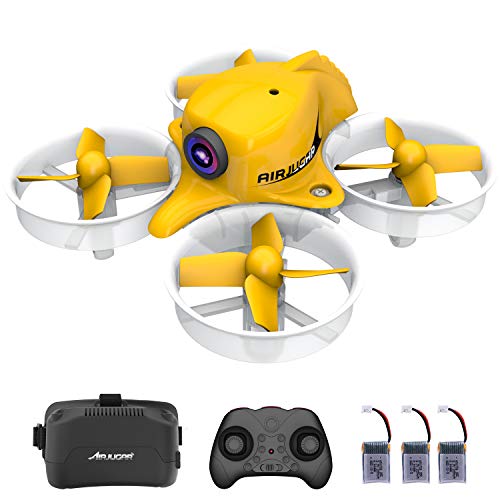
- Flight Time: 5-7 minutes
- Camera: HD camera with 120-degree FOV
- Flight Features: Altitude Hold, Headless Mode, 3D Flips, VR FPV
The AIRJUGAR FPV Nano Drone is probably the cheapest drone you can purchase to get a VR drone. For a little less than $100, it’s a steal indeed! But does it give a legit VR experience?
The VR headset included with the AIRJUGAR is a box type goggle with a single 3-inch screen. It has a 900 x 600 resolution with a camera FOV of 120- degrees. View wise, it’s broad enough for our tastes!
The goggles are as basic as you can get, and there’s not much in the way for adjustments. However, they do fit a wide range of people and is comfortable enough to be worn for minutes at a time. The contour of the goggle fits snugly on your face.
Transmitting at 5.8 GHz, the onboard camera transmits a smooth video feed for FPV mode. For a small drone, the smoothness and quality of it are surprisingly well done.
Performance-wise, the drone itself is a small flyer that’s quite fast and zippy. It’s definitely a joy to fly around and feels light enough to pass as a racing drone. It has a flight time of just only 5 – 7 minutes, less if you use FPV continuously. The silver lining is that it includes 2 spare batteries, so it does extend your total flight time to around 20+ minutes.
In terms of features, however, it’s a little down to the basics. You do have features like Altitude Hold and Headless Mode, the latter of which shouldn’t be used in FPV mode anyway. You also have some one key stunts thrown in for good measure, but that’s about it.
But for a complete VR drone package, the AIRJUGAR FPV Nano Drone is a good introduction.
+ Pros
- Cons
No products found.
No products found.
This is a fast and mobile drone that has a pretty decent FPV mode, enhanced by the inclusion of the VR goggles in this package.
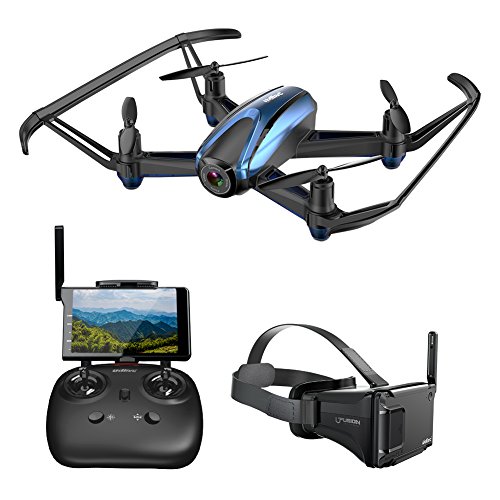
- Flight Time: 7 minutes
- Range: 30m
- FPV Headset: Box goggles with a detachable screen
- Weight: 85g
The so-called VR Goggles included with the Potensic U31R is actually just a “placeholder” for the removable LCD screen. This is the same screen that you can mount to your remote controller to act as an FPV monitor.
In reality, this setup is ideal since you can freely use an FPV monitor or goggles as you wish. It doesn’t also detract from the overall experience of using the VR goggles, which has terrific color definition and picture quality. It’s pretty immersive in its own right.
FPV is fed through the U31R’s 720p HD camera. The 5.8 GHz transmission is powerful enough to keep the video smooth and lag-free, although the drawback is that it works at a very short 30m range. Beyond this, the footage begins to get choppy. This limits the U31R to just short distance flight.
Good thing it has a lot more going on for it. It has One Key Takeoff and Landing to make launching and landing that much easier while in FPV. Its Altitude Hold feature also makes hovering and flying in general quite easy.
For racing around, the U31R also has three speed modes, so you can switch between ripping racing and casual flying.
Flight time is pretty short at 7 minutes, but it does have an extra battery included, which extends that further up to 14 minutes in total. Still short, relatively speaking.
Nevertheless, the Potensic U31R is a good mid-range drone to help you get into the VR drone experience.
+ Pros
- Cons
No products found.
The Tello is available as a package that is geared for a VR experience with the included Xtreme Vue II VR Headset.
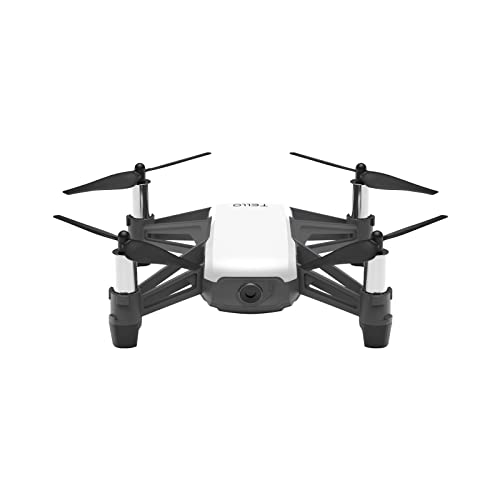
- Flight Time: 10-15 minutes
- Charge Time: 75 minutes
- Range: 100 meters
- Remote Controller: none included; uses a smartphone app for control
- Camera: 5 megapixels at 720p HD resolution
- Weight: 82g
- Rated for indoor and outdoor use
The Tello Quadcopter is DJI’s “unofficial” budget drone. This is because it’s made in collaboration with DJI, using much of their technology. The Tello is available as a package deal with the Xtreme Vue II VR Headset if you look in the right places (Amazon).
This is a lightweight FPV goggle, which requires the use of your smartphone to work. Despite this, the headset is capable of being highly immersive. It is more than enough to perfectly match the FPV output of the Tello.
The FPV of the Tello is powered via a 720p HD video camera, capable of capturing surprisingly decent photo and video quality. It’s comparable to that of a mid-range smartphone.
The range of the FPV transmission is relatively long for a drone at this price range. It’s capable of distances of up to 100m, allowing much leeway into how far you can wander off. This also gives it a strong signal strength when using the Tello at shorter distances.
Performance-wise, this is one of the better budget drones you can buy. DJI’s influence on this drone is highly evident based on its ease of flight and durability.
As a beginner, you can take advantage of its many easy flight modes. These include an Auto Takeoff/Landing feature, which makes launching and landing hassle and error-free. For an FPV drone flown while in VR, this is crucial to have.
The Tello also has flight sensors installed underneath it, which allows the drone to maintain its position accurately. It’s visual-based, however, so it needs lots of light to work. This makes it rather challenging to fly the drone at night.
The flight time of the Tello is at an impressive 13 minutes, a feat that few other starter drones can lay claim to.
All in all, the Tello Quadcopter might be the best beginner drone to get. With DJI backed components, you definitely can’t go wrong!
+ Pros
- Cons
Forget flying, this underwater VR drone is capable of deep diving for up to 2 hours.
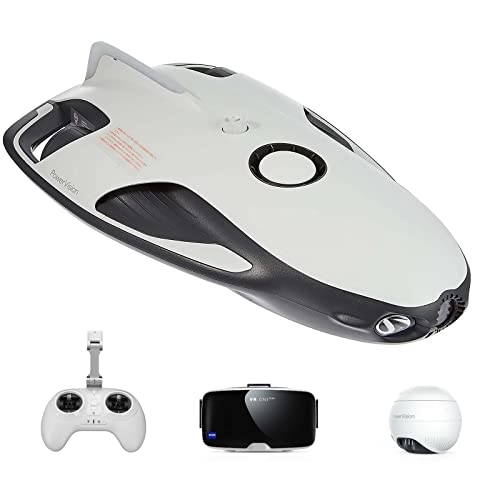
- Operating Time: 2 hours
- Range: 30m underwater
- Transmission Range: 80m
- FPV Headset: ZEISS VR ONE Plus Goggles
We figured we’d try out a completely different drone experience, so we checked out the PowerVision PowerRay. This underwater drone allows you to deep dive into ocean depths and see a brand new world beneath the waves.
The PowerRay works just like an aerial drone, with the difference of course that it’s underwater. It’s equipped with a 4K UHD camera that enables it to capture breathtaking underwater scenes and still photos at 12-megapixel resolutions.
The camera, of course, also allows you to operate the drone in FPV mode. This is paired with the included Zeiss VR ONE Plus Goggles, which work by using your smartphone as a screen. With a built-in WiFi transmission and shorter range, the video feed data is quite smooth and lag-free.
If you ever wanted to try out diving but don’t know how this is the closest you can get! You’ll feel as if you’re right there in the water swimming. It’s a safe way to explore and view marine life, or even go on a treasure hunt.
The PowerRay has several uses beyond just taking photos or exploring underwater. You can also use it as a fishing aid by helping you visualize fish as they catch your bait. This package has an included PowerSeeker, which you can attach to the PowerRay to drop the bait and locate fish underwater.
Unlike aerial drones, the PowerRay has a longer operating time of around 2 hours.
So, in our experience, we had lots of fun taking the PowerVision PowerRay out for a spin. It might be a bit pricey, but seeing underwater scenes in VR makes it worth the cost.
+ Pros
- Cons
Buyer’s Guide: VR Drones
At its core, a VR drone is just essentially an FPV drone with goggles. Therefore, getting a good FPV drone usually translates well into a stellar VR experience.
Here are some consideration you need to make for FPV and VR drones:
FPV Frequency
A drone’s signals usually travel in specific frequencies. In the case of an FPV drone, the control signal for the flight should be in a different frequency as the FPV video feed.
Drone frequencies range from 900 MHz all the way to 5.8 GHz. Frequency controls a lot of a signal’s characteristics. Lower frequencies allow for a more extended range since a signal can travel farther, plus they can easily penetrate through obstacles. However, they also have lower bandwidth, so video transmission in lower frequencies are often inferior in quality.
The two most commonly used frequencies are 5.8 GHz and 2.4 GHz. There are plenty more, like the newer 3.3 GHz, but a lot of them are illegal to use in most countries.
5.8 GHz is the most widespread and popular frequency. It provides a high data rate, so live footage quality is better. It also has a decent range, is legal in many countries, and is cheaper to produce. Plus, it doesn’t interfere with the control signal, which is usually in the 2.4 GHz and 900 Mhz channels.
The other frequency, 2.4 GHz, offers a better range but does not have high bandwidth like 5.8 GHz. That’s why it’s mostly used for controlling the drone.
This is also the frequency that WiFi uses, hence why most drones are WiFi-compatible. This makes it possible to connect to your smartphone, allowing you to control your drone. While inexpensive with decent range, 2.4 GHz can encounter a lot of interference with other wireless devices and appliances.
Now, why is this important? Because it determines the range of your drone, which we’ll cover next.
Range
The range is a simple way to describe the transmitting power of your drone. The more powerful it is, the further out it can travel. This means you can control your drone from longer distances with a more extended range.
As we mentioned, the control signal and FPV signal are two totally different things, each operating separately. Since FPV has a more significant demand in terms of bandwidth, the FPV range is usually shorter than the control signal. The best case, of course, is to have them both at the same distance.
A longer range doesn’t just mean you can go out at bigger distances. Because the signal strength is stronger, this makes for a better control signal as well for shorter distances. Your drone becomes much more responsive, and there’s less risk of the signal dropping while flying your drone.
The range is totally dependent on your application, but aim for a range of 500m and up, except for racing drones where 100m or shorter are the norms.
Camera
The camera is the primary way that the drone sees its environment, so this is an important consideration as well.
Note that the camera’s resolution doesn’t necessarily mean it’s the resolution the FPV will be on. Since higher resolutions like 4K are more bandwidth-heavy and might introduce lag, FPV is usually done at lower resolutions like 720p or 1080p HD. In either case, these are actually good enough. Just make sure your transmission system can handle the added load on 1080p.
Apart from resolution, Field of View (FOV) is another important consideration. This controls how much of the environment you can see. Higher FOV will give you a broader, more panoramic view. This is especially useful for racing drones since you can see more fully and react much quicker around obstacles.
For flying outside of racing, FOV is a matter of preference, but we’re partial to FOVs of around 120 – 130 degrees.
Flight Time
Flight time is that one thing drone pilots can’t get enough of! Of course, “the longer, the better” is the goal here. How long your drone can fly depends on its battery capacity. The bigger the capacity, the longer it can fly.
Battery life is vital when flying in FPV mode because the continuous live streaming of video feed in real-time can drain the battery that much faster. Therefore, you need a much bigger capacity to enjoy FPV flying more.
We recommend a minimum of around 15 minutes of flight time. This is usually the maximum when you’re flying conservatively, and turning on FPV will get you far less than that. So it’s better to have a buffer of sorts.
Of course, if your drone has a short flight time, the workaround is to have spare batteries on hand. These can extend the time your drone can fly, with only a small delay in between for swapping.
Easy Takeoff/Landing
When you’re flying in FPV mode, it can be a challenge to launch and land your drone. It takes some precision, which can be relieved by a simple feature called One Touch Takeoff/Landing.
With One-Touch Takeoff/Landing, you can do the entire taking off and landing sequence with just the push of a button. This is handy when you need to land your drone in a hurry when you’re in an emergency, for example.
GPS Features
Having an onboard GPS is a great tool to assist you when doing FPV flights. It opens up a host of autonomous features you might find useful.
The most crucial of them is Auto Return to Home. This makes the drone return to its takeoff point automatically whenever its battery gets critical, or if the drone goes beyond signal range. It saves you the time of having to maneuver and find a landing spot yourself. Plus, sometimes flying gets so immersive you might lose track of your drone’s battery levels.
Then you have other autonomous flight modes, like Waypoint Mode. This mode allows you to lay down points that your drone will follow automatically. If you want to let the drone go on autopilot and simply be there just to enjoy FPV, then you might want to try this one.
You can also try things like Orbit Mode, which directs the drone to automatically circle around a point of interest, such as a landmark. Again, it allows you to enjoy the 360-view without having to control the drone manually.
Obstacle Avoidance
One of the problems of flying in VR mode is that you can’t see beyond your drone’s vision range. And since you won’t have the peripheral vision or perception like you usually would, you’ll have blind spots to your drone’s sides and back.
This makes you prone to hitting obstacles on those areas and makes backward and sideways flying particularly risky. This is the one advantage of Line of Sight because you always see the drone’s surroundings at all times.
The way around this is with an Obstacle Avoidance System. Drones with this feature have sensors on the front, as well as on the sides and/or back, depending on the drone. These sensors are capable of detecting obstacles in advance. It will then either inform you so you can avoid it, or instruct the drone to maneuver around them automatically.
The VR Headset (or FPV Goggles)
Of course, a VR setup won’t be complete without a proper VR headset, also called FPV goggles. Since it’s such a vital part of the whole experience, it’s worthwhile to find the best one for you.
Here are a few things you need to consider with FPV goggles
Types of Goggles
There are generally two types of FPV goggles: box and low-profile or slimline goggles.
Box goggles are nothing more than a 3 to 6 inch LCD screen fitted onto a headset. Some VR headsets don’t have one built-in, relying on your smartphone to act as the screen.
Since they utilize a larger screen, box goggles tend to be bigger and heavier, which can put a strain on some people. One the other hand, some users find the bigger frame of box goggles much more comfortable to wear. Box goggles tend to be cheaper too, so there’s that.
Low profile or slimline goggles, on the other hand, uses two smaller LCD screens, one for each eye. Because of their size, these tiny screens can be placed closer to your eye, allowing these goggles to be much more compact.
Slimline goggles have the advantage of compactness and weight. Since they’re lighter, they don’t put too much strain on the wearer’s head. They’re also much more portable than box goggles.
In the end, choosing one over the other is a matter of budget and preference. Both will give you an immersive experience, but you have to choose the one that’s comfortable for you.
Aspect Ratio
The FPV goggle’s aspect ratio refers to the ratio of the screen width vs. the height. In VR headsets, they come in either 4:3 or 16:9. While choosing one over the other is mostly based on preference.
An aspect ratio of 4:3 is the one most commonly used by drone cameras, hence why most VR headsets have it as a default. It results in an almost square frame that feels like having a narrower FOV.
16:9, while still uncommon, is quickly gaining in popularity. This is due to the fact that this aspect ratio is wider, giving a much more cinematic feel and broader field of view.
Whichever you choose, however, you do need to match the aspect ratio of both your VR headset and the drone for the best results. If not, the footage on your FPV will not display as expected.
For example, most FPV drones transmit at an aspect ratio of 4:3. If you used 16:9 VR goggles for it, then the live feed will look stretched. If the reversed happened (4:3 goggles with 16:9 drone), then the footage will look squished.
The good news is that some goggles can switch between 4:3 and 16:9. Most achieve this by cropping the footage instead of squishing/stretching it, avoiding a distorted look.
Resolution
Like your camera, resolution refers to the total number of pixels your FPV goggle can display. Most goggles come in resolutions ranging from 320 x 240 all the way to 1280 x 720.
Generally speaking, the higher the resolution, the better the picture quality. Or at least, that’s how it’s supposed to be.
With FPV, however, it’s not as simple as that. The quality of your video stream will still largely be dictated by the drone’s camera and, most importantly, video transmitter.
Basically, what we’re saying that you won’t benefit much from a 1080p HD or even 2K resolution goggles if your drone is only capable of streaming in 720p HD.
By the way, aspect ratio and resolution also go hand in hand. For analog transmission (the usual with racing drones), the resolution of the video is usually in the PAL or NTSC format, which is 720 x 576 and 720 x 486, respectively. Both benefit with goggles that have a 4:3 aspect ratio and 800 x 600 resolutions.
For digital FPV cameras, the resolution is usually sent at 720p HD. In these cases, a 16:9 aspect ratio with 1280 x 720 resolutions is the way to go.
Goggle FOV
The goggle’s FOV is, in simple terms, how far the screen is from the user’s eye. In technical terms, this is measured as the angle between the eye and the corners of the FPV screen.
The wider the angle, the bigger the screen appears, and the more immersive it is for the user. However, there is a limit. If the screen becomes large enough, the eye needs to move around to be able to see different parts of the picture.
You can easily see this action by placing your smartphone in front of you. Too close, and it’s hard to see, too far away, and it becomes less immersive and less detailed.
Box goggles have a typical FOV range of 50 – 80 degrees, while low profile goggles have 25 – 50 degrees. Goggle FOV is a matter of personal preference; however, 30 degrees seems to be the absolute minimum. Anything lower than this can make the drone hard to fly in FPV.
Interpupillary Distance (IPD)
Interpupillary Distance (IPD) refers to the distance between the two pupils, a fact that is relevant to two-screen low-profile goggles. If the IPD of your goggles and your eyes don’t match, the footage you see will appear blurry.
You can opt to try on a goggle before buying to see if it matches your IPD, but you can’t always do this. Your best bet is just to buy goggles with adjustable IPD. This allows your goggles to be flexible enough to be used by just about anyone.
Internal Fan
One of the most annoying things when wearing goggles is fog forming on the lenses. This is especially prevalent in hot or humid weather. To combat this, some FPV goggles have a small fan built-in that blows a stream of air to remove any fog forming.
This is a highly recommended feature to get when shopping for goggles!
HDMI Output
Some goggles have an HDMI port that allows you to connect the goggles with a whole slew of computers and devices. One common use is connecting it to a computer with an FPV simulator, which allows you to train using a virtual simulated world.
Or you could just connect it to watch movies using your FPV goggles.
Digital Video Recording (DVR)
Goggles with DVR capability allow you to record your video feed onto an SD card inserted into your FPV goggle’s port for later viewing. This is particularly useful for drone racers, as they can use it to review racing performance after a competition.
It’s also an added insurance policy to record drone crashes to find out the ultimate cause of it. This serves the same purpose as a dashboard camera mounted on cars.
Tips for Flying in VR Mode
While flying in VR mode can be immersive, it can also leave you vulnerable as you can’t see anything else! Here are a few tips and safety precautions you need to consider first to fly in VR as issue-free as possible.
Don’t fly in a crowded place
Flying FPV mode in a crowded area is a bad idea, both for you, the drone, and everyone around you. For one, operating a drone with many people in it is dangerous, FPV or not. You have a much higher chance of hitting someone, putting both your drone and the person at risk.
Also remember that when you’re piloting in FPV mode, you’re basically a sitting duck. This makes you a juicy target to pickpockets and thieves! At the minimum, people might knock you over, causing severe injury to you and your gear.
If possible, have someone near you
If you absolutely have to fly in a public place with some people walking around, be sure you’re not alone. Have someone to spot you and watch over your things. He or she can make sure both you and the people around you are safe from your drone piloting.
Turn off Headless Mode
When you fly in FPV mode, whatever you do, don’t turn on Headless Mode!
If you’re not sure what it is, it’s a beginner mode that allows you to control the drone regardless of its orientation. Turning left will always make the drone turn left based on YOUR orientation, irrespective of where the drone is faced.
By now, you should see how much havoc this can cause when you’re in FPV! Because your orientation and the drone’s are now one and the same, turning right on the controller will not necessarily make you turn right! It can quickly turn into a convoluted mess!
So reserve Headless Mode when you do Line of Sight (LOS) flying.
Take breaks
VR is an immersive experience, but it can also be very disconcerting if done for long periods. Not to mention, it can cause strains to your eyes if you’re staring at a screen for too long. Prolonged VR exposure can also make you start to lose orientation of the real world when you take off your VR headset.
So take break times off the VR headset in between flight runs. We recommend taking a break every 30 – 45 minutes of flying.

